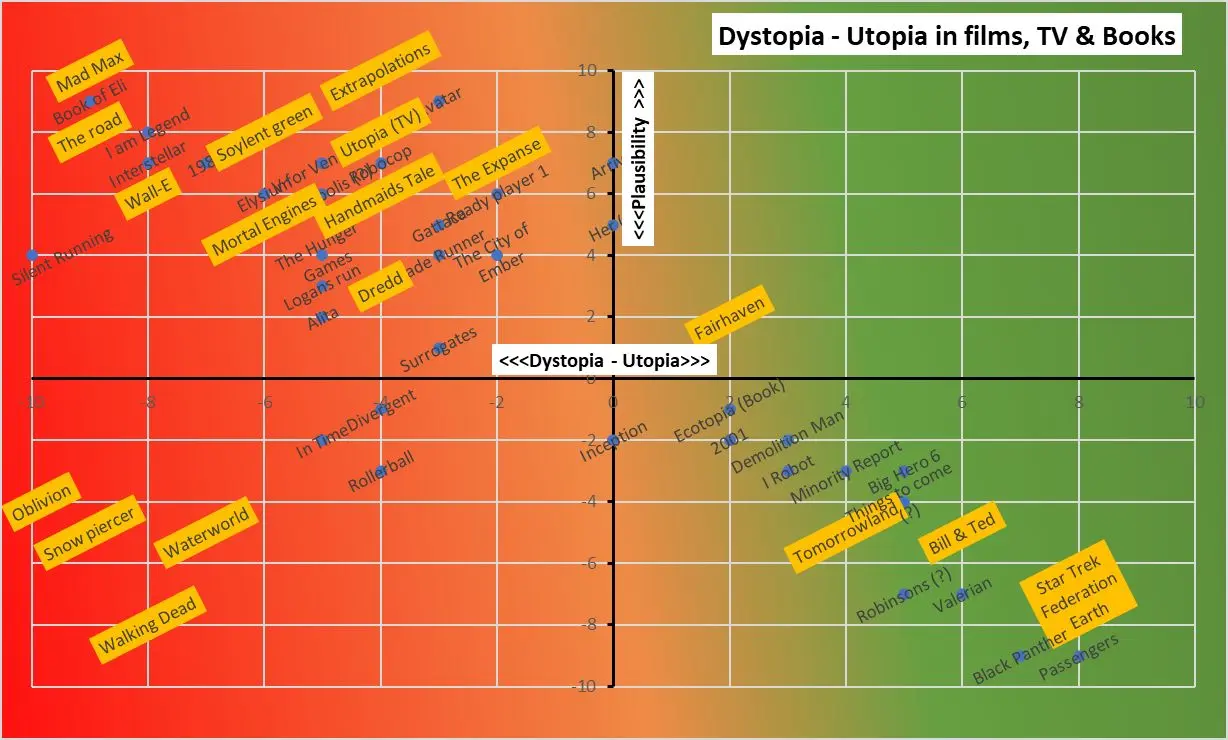
Imagination is essential to our progress, yet it’s often overshadowed by the incessant churn of policies, regulations, and frameworks that lack the visionary spark necessary to inspire real change.
I recently read a post on this 2 by 2 matrix of Doom, Despair, and Dystopia which came via Sven von Vittorelli that deserves amplification and circulation through the nozzles here at Near Future Laboratory. (h/t to Gabby Morris for pointing it out!)
Sven is a science fiction writer curious to wonder (somewhat emphatically) why we do not (or cannot?) have more plausible futures science fiction. Hence, the meaning of the 2 by 2 matrix above that shows that there are more doom-y science fiction television shows than not. (We’ll trust that the full data set of all television shows would correlate to this and we’re not selectively leaving out plausible more utopian science fiction shows.)
Now, there are reasons for this prevalence of dystopian science fiction: doom, struggle, despair, good-versus-evil played out on a cartoonish scale — all of these things “sell” and ‘shows’ (what we once called ‘television’) needs lots of people to be sold on a show enough to watch it so that networks (what we once called ‘television stations’) can sell advertising and make money.
But besides this (somewhat obvious) point, the observation in Sven’s post is that we are inundated with dystopian narratives in media, at the expense of a dire shortage of utopian visions. That is plausible, positive futures that we can genuinely aspire to. This imbalance not only stifles hope but also hinders our ability to mobilize collective action towards sustainability. As Sven points out, if we cannot imagine a future worth striving for, how can we expect to overcome the complex challenges that lie ahead?
Yes. That. And-also how do you pitch a show about the ordinary? Is that even possible?
Is there Seinfeld..but from some plausible near future? (That’s actually a curious pitch line, come to think of it.)
In any case, this conversation naturally brings me to the intersection of Imagination and Design Fiction. Design Fiction isn’t merely about spinning stories; it’s about materializing futures through artifacts—creating tangible pieces of a possible world that allow us to experience, critique, and iterate on potential outcomes. It’s a practice that goes beyond speculative thinking, providing a scaffold upon which we can build and explore future scenarios with depth and clarity.
What distinguishes Design Fiction from science fiction, as Sven’s post implies, is that Design Fiction is grounded: it is grounded in the practical, the normal-ordinary, the mundane and the material of the everyday. While science fiction may inspire us to imagine distant possibilities, Design Fiction takes those imaginings a step closer to ‘us’ — to this moment — bringing these imaginings into the realm of the possible-plausible through the material-making practices of design. It’s not just about asking “What if?” but about answering “What now?” in ways that are meaningful, actionable, and grounded in today’s realities.
In this context, the absence of utopian visions in our media landscape becomes not just a cultural gap but a missed opportunity for Design Fiction. Imagine if, alongside every dystopian tale, we had a design fiction artifact that offered a glimpse into more habitable futures — ones where sustainable practices, equitable societies, new ways of organizing human value creation (‘futures of work’, ‘futures of organizations’) and so forth are reflected in tangible, relatable forms. These are the kinds of visions that could shift the narrative from despair to hope, from inaction to engagement.
Imagination, as the Sven emphasizes, is not a luxury; it’s a necessity. It is that which creates the inspiration to do something. (Consider that Imagination, for better or worse, is what gets someone to feel inspired enough to sit down and write a pitch for a science fiction television show).
Repeat after me: Imagination leads to inspiration. Inspiration leads to Innovation.
Imagination is the precursor. The key ingredient. The starter.
Imagination becomes the compass that guides us towards the futures we want to create and inhabit. Design Fiction, in its unique capacity to materialize that which we imagine is a vital utility — a kind of tooling that is integral to this flow of feeling from vaguely articulate notion to something changed in the world. It is a process that starts with creating artifacts that embody our best possible futures. We just need to activate it zealously, which sadly seems that we have difficulty doing.
So, while economists and policymakers are crucial, we must also elevate the voices of those who can craft these visions—writers, designers, and thinkers who understand the power of Imagination. They are just as essential in our quest to build a sustainable, equitable future. Without their contributions, we risk becoming stuck in the present, endlessly preparing for the worst instead of striving for the best.
Let’s not just imagine better futures — let’s materialize them. Let’s put Imagination and the Structures that can create the worlds we dream into rich, meaningful collaboration.
By materializing utopian visions, Design Fiction can shift the narrative from despair to hope, inspiring collective action towards sustainability. This conversation starter in the form of this visual 2x2 matrix allows us to amplify this perspective and hopefully inspire more plausible futures visions beyond just the doom-despair-destruction variety, even as those more typical variety of visions have their place. I don't think it's helpful to dig in too hard on one side or the other. Rather, finding the way to 'fill out' the matrix possibly or be creative such as to imagine other genres of futures visions that can operate successfully in the other quadrants of this matrix. Like Seinfeld...but from some possible future.